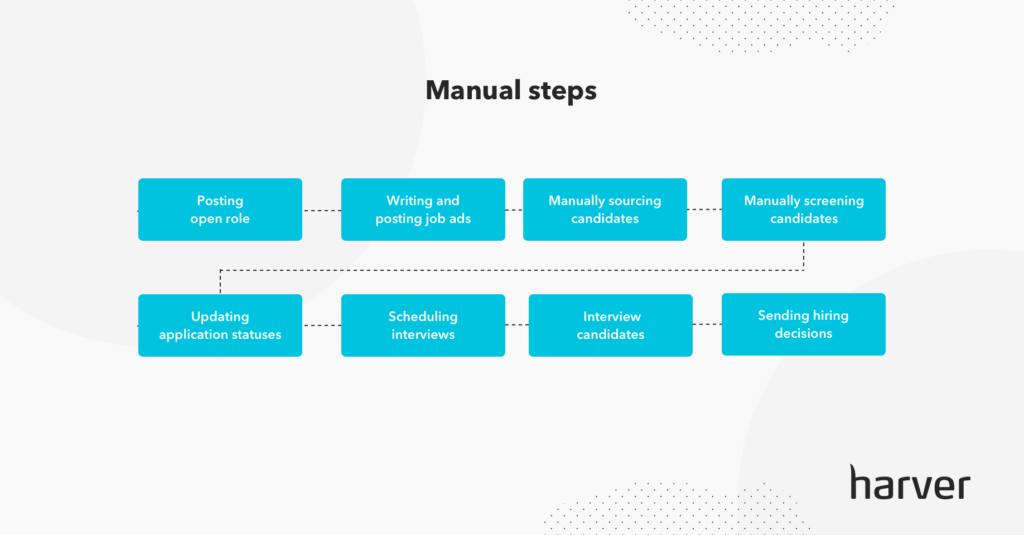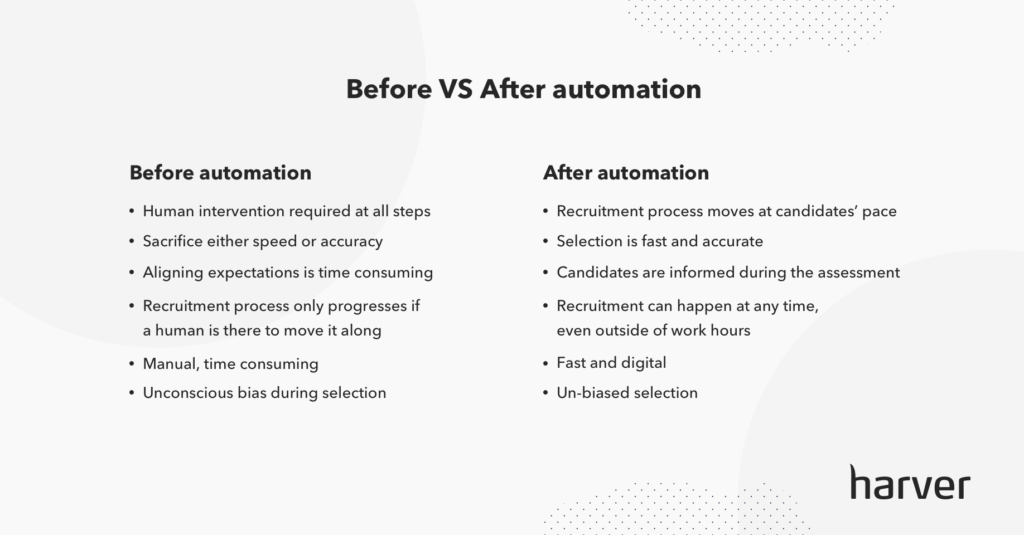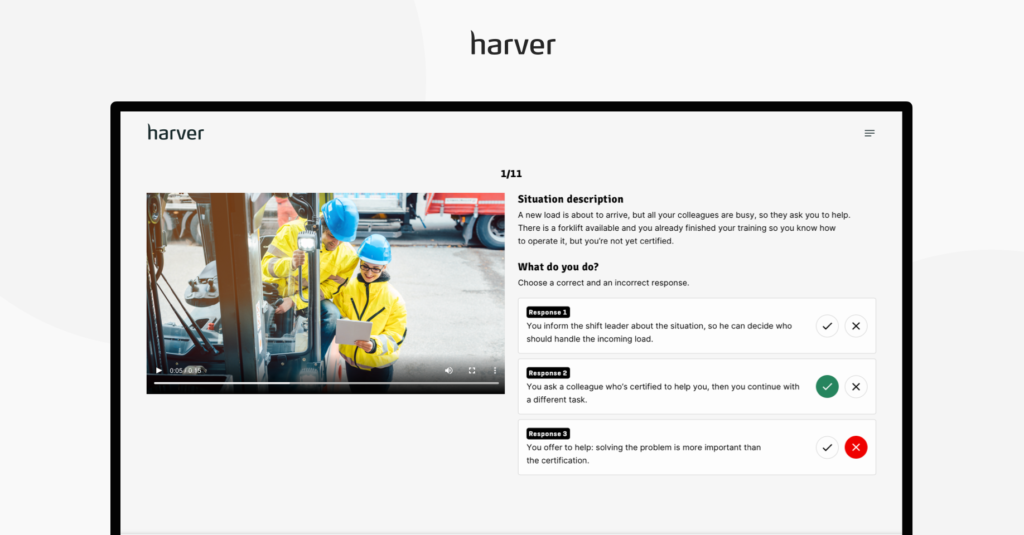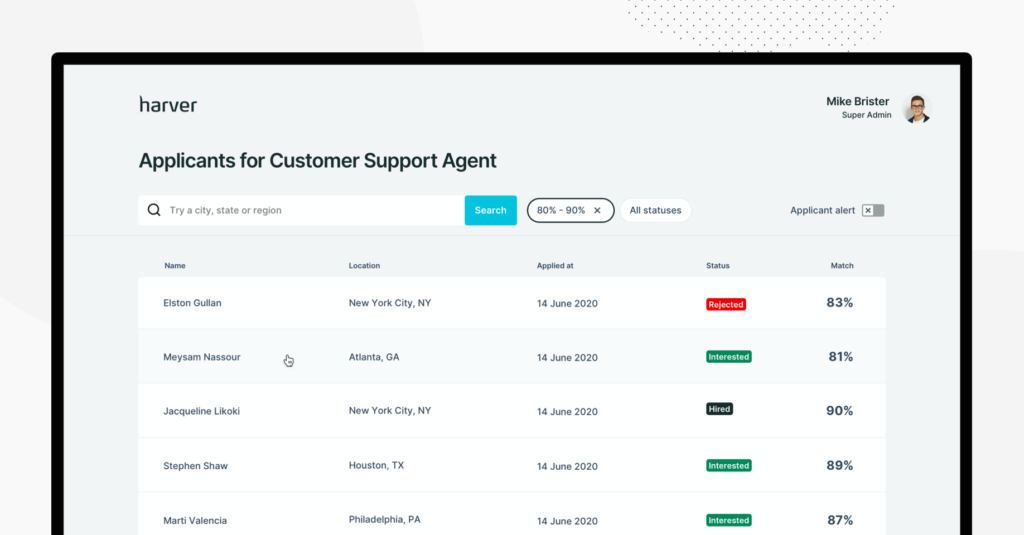For any business operating warehouses or fulfillment centres, meeting consistent demand for high-quality staff is critical to business operations. And, with labor making up between 50-60% of the total cost of warehouse operations, having the right recruitment and retention strategy is just as important for the health of the bottom line as it is for fulfilling orders.
Yet, many warehouses are still relying on manual processes to fill their roles, resulting in a slow time to hire and high attrition rates across the industry.
Warehousing is mission-critical to a number of industries, and hiring the right workforce is key to delivering on your business’ promises. Just as inventory management and tracking can all be done better with the assistance of technology, so can recruitment.
Let’s take a look at opportunities to automate key recruitment tasks when hiring warehouse workers, and how it can make your process faster, more effective, and reduce costly employee turnover.
What’s in?
The challenges of warehouse recruitment
Before we explore how an automated recruitment process can improve your warehouse recruitment process, let’s review some of the main challenges warehousing TA teams are facing.
Costly manual processes
In the US alone, there are over 18,000 warehouses across the country employing nearly 1 million people. Even with the rise of robotics and fulfillment technology, warehouses can have anywhere from 100 to 1000+ employees working on-site during a single shift.
With attrition rates as high as 100%, warehouse recruiters are hiring at extremely high volumes to keep operations running smoothly, and this involves a distinct set of challenges from regular hiring. Namely, manual processes like resume screening, scheduling, interviewing, and on-boarding are typically repetitive, time-consuming, and costly.
When leaning on a team of recruiters to step in at each part of the process to complete a manual task, you’re left with a hiring process that is slow and doesn’t always result in the best recruitment decisions.
High early turnover
While there are a number of factors that contribute to turnover, from low pay, to lack of growth opportunities, the biggest contributor to turnover is typically mis-aligned candidate expectations.
Often, candidates come onto the job without a real understanding of what they signed up for, and they leave. This is only worsened when volume hiring, as recruiters don’t have the bandwidth to set a standard expectation when screening hundreds or thousands of candidates.

78%
of employee turnover in warehousing has nothing to do with wages.
Source: Industry Today
Competition for talent
Even with unemployment higher than it was several years ago, competition for warehouse talent is still high.
Firstly, because workforce demographics are changing and there are less young people entering the industry. Additionally, because job opportunities are plentiful and candidates are overwhelmed with opportunities — especially in areas with high concentrations of warehouses, like Atlanta and Chicago.
This means that your recruitment process needs to combine selling and selecting. While it’s important you’re looking for the best talent, you also need to engage them and you need to do it quickly — otherwise they may be hired by your competition first.
Mis-hiring
Because of the often physical nature of working in a warehouse, many teams make the mistake of hiring without using a tool to predict success. Even in roles where just being able to work certain hours, or be on your feet for long periods of time are crucial, your employees also need the right skillset and disposition to succeed.
In addition to knockout questions, like scheduling needs or certifications, you should also be able to quickly identify which candidates will be successful during the application process using technology. Conducting behavioral interviews or in-person job tryouts isn’t feasible at scale.
Like what you see?
Don’t miss out. Subscribe to our monthly digest to get the latest TA and TM resources delivered right to your inbox.
How automation can help tackle these challenges
As we’ve seen, warehousing remains a competitive market for talent, where organizations need to source, screen, attract and hire high volumes of candidates quickly.
Manual processes are costly and steps that can be automated, should be automated. To decide what to automate, let’s recap the goals of your warehouse recruitment process:
- Attracting candidates with a fast and informative process
- Efficient and accurate candidate selection
- Reducing attrition by aligning candidate expectations
Now, let’s take a look at a sample recruitment process that’s being handled manually.

In the process above, you lose time at every step because a recruiter needs to complete a task to move the candidate forward. Thus, the more candidates you have, the more time you’ll waste with administrative tasks.
So which parts can and should be automated? In short, anything that can be done more accurately and efficiently by technology than a human. For example, automating candidate selection and scheduling can immediately improve the efficiency of your recruitment process.

Now let’s dive into automation across the stages of the warehouse recruitment process.
Sourcing
Before we get started with automating your recruitment process, be sure to consider your sourcing. Especially in a competitive environment, sourcing will be key to the success of your recruitment process as it determines the quality of the talent pool you’ll hire from.
To evaluate your sourcing methods, take a look at this guide to digital sourcing, and then head back to see how this fits into a warehousing recruitment process.
Candidate selection
When automating candidate selection, it’s critical that your recruitment methods are both informative and highly accurate.
To ensure accurate selection, you can use pre-employment assessments that are both scientifically validated and predictive of success in the role. The focus of these tests should be on assessing the skills required for the warehousing roles, while ensuring that candidates are a good fit for your company culture.
In warehousing, both personality questionnaires and cognitive ability tests are commonly used, particularly at the management or management-in-training stage. However, for entry-level positions where personality or cognitive abilities are less of a factor for success, situational judgement tests (SJTs) can be a much more reliable predictor of performance.
A situational judgement test is a digital job preview, where candidates are presented with a critical situation they might encounter on the job and are asked how they would respond.

Above you can see an example of SJT developed by Harver. Each question comes with three potential answers, scored from best to worst. As candidates go through the application and answer the different questions, they’re assessed for job-fit, and recruiters can see each candidate’s scores in the backend of the platform.

In addition to helping gauge a candidate’s potential for success in the role, situational judgement tests help align candidate expectations by showing them the reality of the role, and enable recruiters to gather insights into how a candidate would behave in a real scenario.
Also, such pre-employment assessments test an applicant’s behavior, rather than their knowledge, to field candidates without direct experience. And finally, SJTs allow candidates to self-select out if the role isn’t right for them.
With your selection automated, you drastically speed up your hiring process, from apply to interview.
Stop guessing,
Start data-driven hiring.
Learn how you implement a modern candidate selection process, that is: streamlined, experience-driven and backed by data.

Interviewing
Beyond screening and selection, interviewing can be one of the biggest bottlenecks in the warehouse recruitment process, mostly because of the time it takes to schedule the interviews.
Thankfully, automated interview scheduling can drastically reduce time to fill and improve the candidate experience by providing applicants with timely feedback.
In the Harver platform, the matching score from the assessment phase is calculated automatically, so by the end of the application process, the system can identify candidates who are a good fit and prompt them to interview.
In some instances, where a recruiter is readily available during the hours an applicant applies, Harver technology can even enable on-demand interviewing — where a candidate can begin interviewing if they’re ready 7-10 minutes after completing their application.
This means that your recruitment process moves along 24/7, with no assistance from recruiters or hiring managers, and that human intervention is only needed during the interview and after, to make the hiring decision and trigger it in your ATS.

Onboarding
Automation doesn’t have to stop once the recruiter makes a hiring decision. Especially with high competition for talent and attrition as a common challenge within the warehousing industry, you also want to make the transition from applicant to employee as pleasant as possible.
After all, you’ve just delivered an extremely fast and engaging recruitment experience — you can’t leave them hanging with a laggy onboarding as the final step. Bottlenecks or frustration during onboarding or training can easily harm all your efforts to make your candidate experience enjoyable.
Thankfully, because of the same tools that enable your automated recruitment (CRM, HRMS, ATS), you have what you need for a fast and easy onboarding that saves time for your team and your new employees.
To automate some steps of on-boarding, you can:
- Trigger an automatic welcome email when a candidate is marked as “Hired”.
- Include FAQs, all necessary information, and an overview of training and onboarding in the welcome email.
- Automate scheduling for training and on-boarding.
- Allow new-hires to upload their legal documents to avoid issues on their first day.
Onboarding thoroughly digitally helps move the applicant smoothly into your organization. Luckily, by freeing up hiring managers and recruiters of routine selection and scheduling tasks, they should now be able to quickly address any questions or concerns of new hires.
We’re written more extensively on this topic in the guide to remote onboarding below.
The benefits of a fully automated hiring process
Let’s recap the main challenges of warehouse recruitment, and how automation has alleviated them to make the process fast and candidate friendly.
More efficient hiring
Instead of scaling your recruitment team every time you need to hire more employees, you can let technology handle the high volumes of applicants for you.
Automating manual tasks in your recruitment process means that more candidates don’t require more time to be screened. By surfacing the right talent automatically, the workflow and workload remain constant no matter your candidate volumes.
Here’s, for example, how Albert Heijn improved their process efficiency after implementing the Harver volume hiring solution.
Lower employee attrition
Candidates are being selected based on criteria which predict success, meaning you reduce your risk of mis-hiring.
Not only that, but your SJTs show candidates the reality of the role during the application process, allowing them to self-select out of the process if they don’t think it’s a fit for them. Every applicant receives the same opportunity to be informed before they accept an offer.
Better candidate experience
Your process is now as informative as it is fast. Automating manual tasks that can take hours or days reduces time to hire from weeks to mere days.
A candidate can move through the entire process in as little as 2-3 days, faster than competitors even review their resume. The lack of friction in the process allows candidates to go through the recruitment funnel faster, meaning you hire more top talent.

Better quality of hire
Selecting candidates using scientifically validated assessments means you are finding talent with the right DNA for your roles. Not only are they less likely to voluntarily attrit, they’re more likely to be successful because they have the same skills and behaviors of your existing top performers.
Cost-effective process
Your process is now fast and accurate. You are suffering less attrition, saving recruiter work hours, and reducing time to hire. The largest cost in your warehousing operation is labor, and now you are hiring the best talent, faster.
Next steps
In warehousing, where competition is as high as the candidate volumes, investing in a fast and automated recruiting process is a sustainable competitive advantage. Especially for high-volume, entry-level positions, automating the manual steps can save you time and money, while allowing you to identify top performers at scale.
If you’d like to see how Harver can support you in automating your hiring process, you can schedule a demo below.

